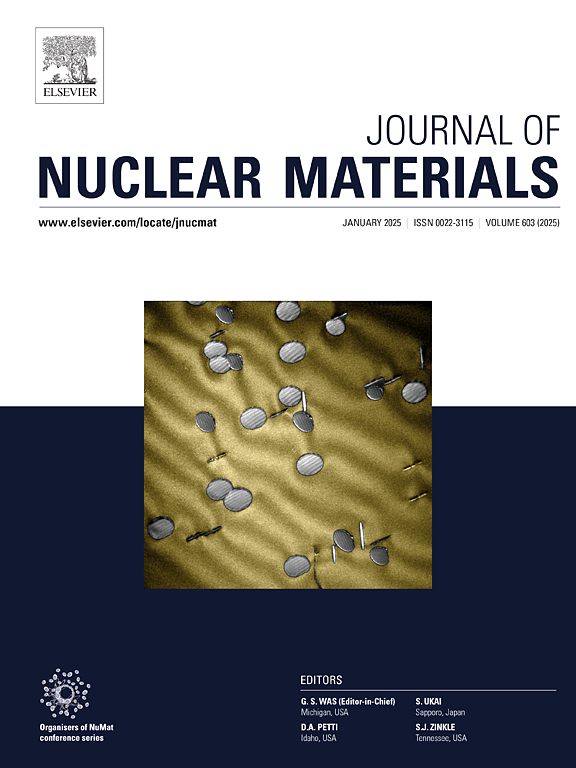利用γ-γ TDPAC光谱研究钛酸锶晶体基质在β和γ辐射下的稳定性
IF 2.8
2区 工程技术
Q3 MATERIALS SCIENCE, MULTIDISCIPLINARY
引用次数: 0
摘要
钛酸锶钙钛矿在SYNROC相组合的形成中起着至关重要的作用,为高放射性废物中的90Sr提供了良好的容纳环境。由于固定的放射性废物发出的辐射,基质经历结构恶化。为了了解β, γ辐射对钛酸锶放射性废物固定化基质稳定性的影响,采用微分摄动角相关(TDPAC)光谱分析了电子束和γ辐照钛酸锶(STO)中的电超精细相互作用(HFI)。先前的研究报道,TDPAC光谱检测到两个不同的相互作用位点,一个与静态HFI相关,另一个与原始STO样品中的动态HFI相关。在本工作中,STO受到1至20 MGy剂量的电子束和γ辐射,以模拟β和γ辐射对固定基质的影响,并观察到hfi。研究结果表明,静态HFI没有变化,表明具有静电场梯度(EFG)的部位具有辐射稳定性。然而,动态HFI被观察到对EB, γ辐射敏感。辐照后动态EFG (τ)的弛豫量增加,但随辐照剂量的增加,弛豫量变化不大。由于缺乏类似研究的文献,因此不可能对β, γ辐照引起的动态HFI变化的原因提供任何见解。讨论了辐射诱导缺陷产生的可能性和STO矩阵对辐射损伤的稳定性。本文章由计算机程序翻译,如有差异,请以英文原文为准。
Understanding stability of strontium titanate crystalline matrix for β and γ radiation by employing γ-γ TDPAC spectroscopy
Strontium titanate perovskite plays a crucial role in the formation of the SYNROC phase assemblage, providing a favorable environment for the accommodation of 90Sr from high level radioactive waste. The matrix experiences structural deterioration as a consequence of the radiations emanating from the immobilized radioactive waste. In an effort to comprehend the impact of β, γ radiation on the stability of the strontium titanate radioactive waste immobilization matrix, Time Differential Perturbed Angular Correlation (TDPAC) spectroscopy has been employed to analyze electric hyperfine interactions (HFI) in electron beam and γ irradiated strontium Titanate (STO). Previous research reported that TDPAC spectroscopy detected two distinct interaction sites, one associated with a static HFI and the other with dynamic HFI in the pristine STO sample. In the present work, STO was subjected to electron beam and γ radiation with doses ranging from 1 to 20 MGy to mimic the consequences of β and γ radiation in the immobilization matrix and HFIs are observed. The research findings show that there is no alteration in the static HFI which suggests radiation stability of the site with static electric field gradient (EFG). However, the dynamic HFI was observed to be sensitive to EB, γ irradiation. The relaxation of the dynamic EFG (τ) increased after irradiation but with dose its behaviour is contrasting. Due to the scarcity of literature on similar studies, it is not possible to offer any insights into the cause for change in dynamic HFI due to β, γ irradiation. Possibility of radiation induced defects creation and stability of STO matrix towards radiation damage is discussed.
求助全文
通过发布文献求助,成功后即可免费获取论文全文。
去求助
来源期刊

Journal of Nuclear Materials
工程技术-材料科学:综合
CiteScore
5.70
自引率
25.80%
发文量
601
审稿时长
63 days
期刊介绍:
The Journal of Nuclear Materials publishes high quality papers in materials research for nuclear applications, primarily fission reactors, fusion reactors, and similar environments including radiation areas of charged particle accelerators. Both original research and critical review papers covering experimental, theoretical, and computational aspects of either fundamental or applied nature are welcome.
The breadth of the field is such that a wide range of processes and properties in the field of materials science and engineering is of interest to the readership, spanning atom-scale processes, microstructures, thermodynamics, mechanical properties, physical properties, and corrosion, for example.
Topics covered by JNM
Fission reactor materials, including fuels, cladding, core structures, pressure vessels, coolant interactions with materials, moderator and control components, fission product behavior.
Materials aspects of the entire fuel cycle.
Materials aspects of the actinides and their compounds.
Performance of nuclear waste materials; materials aspects of the immobilization of wastes.
Fusion reactor materials, including first walls, blankets, insulators and magnets.
Neutron and charged particle radiation effects in materials, including defects, transmutations, microstructures, phase changes and macroscopic properties.
Interaction of plasmas, ion beams, electron beams and electromagnetic radiation with materials relevant to nuclear systems.
 求助内容:
求助内容: 应助结果提醒方式:
应助结果提醒方式:


